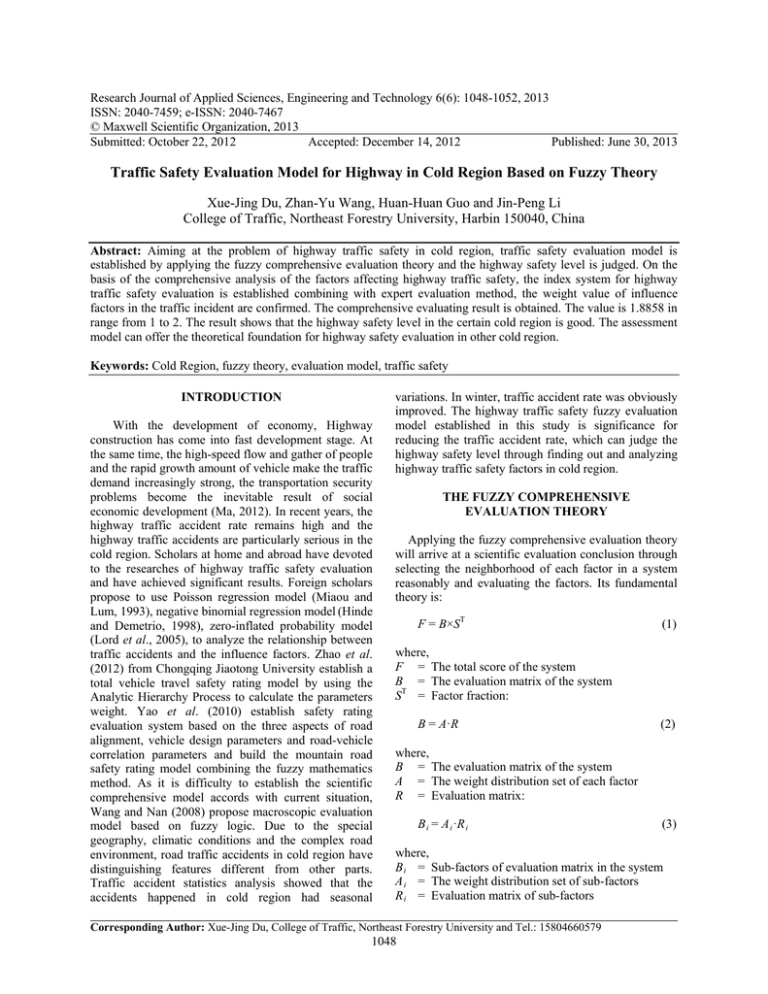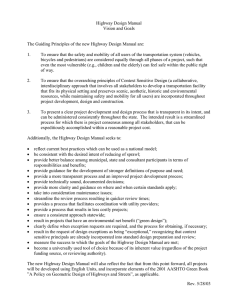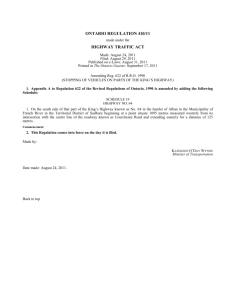Research Journal of Applied Sciences, Engineering and Technology 6(6): 1048-1052,... ISSN: 2040-7459; e-ISSN: 2040-7467
advertisement

Research Journal of Applied Sciences, Engineering and Technology 6(6): 1048-1052, 2013
ISSN: 2040-7459; e-ISSN: 2040-7467
© Maxwell Scientific Organization, 2013
Submitted: October 22, 2012
Accepted: December 14, 2012
Published: June 30, 2013
Traffic Safety Evaluation Model for Highway in Cold Region Based on Fuzzy Theory
Xue-Jing Du, Zhan-Yu Wang, Huan-Huan Guo and Jin-Peng Li
College of Traffic, Northeast Forestry University, Harbin 150040, China
Abstract: Aiming at the problem of highway traffic safety in cold region, traffic safety evaluation model is
established by applying the fuzzy comprehensive evaluation theory and the highway safety level is judged. On the
basis of the comprehensive analysis of the factors affecting highway traffic safety, the index system for highway
traffic safety evaluation is established combining with expert evaluation method, the weight value of influence
factors in the traffic incident are confirmed. The comprehensive evaluating result is obtained. The value is 1.8858 in
range from 1 to 2. The result shows that the highway safety level in the certain cold region is good. The assessment
model can offer the theoretical foundation for highway safety evaluation in other cold region.
Keywords: Cold Region, fuzzy theory, evaluation model, traffic safety
INTRODUCTION
With the development of economy, Highway
construction has come into fast development stage. At
the same time, the high-speed flow and gather of people
and the rapid growth amount of vehicle make the traffic
demand increasingly strong, the transportation security
problems become the inevitable result of social
economic development (Ma, 2012). In recent years, the
highway traffic accident rate remains high and the
highway traffic accidents are particularly serious in the
cold region. Scholars at home and abroad have devoted
to the researches of highway traffic safety evaluation
and have achieved significant results. Foreign scholars
propose to use Poisson regression model (Miaou and
Lum, 1993), negative binomial regression model (Hinde
and Demetrio, 1998), zero-inflated probability model
(Lord et al., 2005), to analyze the relationship between
traffic accidents and the influence factors. Zhao et al.
(2012) from Chongqing Jiaotong University establish a
total vehicle travel safety rating model by using the
Analytic Hierarchy Process to calculate the parameters
weight. Yao et al. (2010) establish safety rating
evaluation system based on the three aspects of road
alignment, vehicle design parameters and road-vehicle
correlation parameters and build the mountain road
safety rating model combining the fuzzy mathematics
method. As it is difficulty to establish the scientific
comprehensive model accords with current situation,
Wang and Nan (2008) propose macroscopic evaluation
model based on fuzzy logic. Due to the special
geography, climatic conditions and the complex road
environment, road traffic accidents in cold region have
distinguishing features different from other parts.
Traffic accident statistics analysis showed that the
accidents happened in cold region had seasonal
variations. In winter, traffic accident rate was obviously
improved. The highway traffic safety fuzzy evaluation
model established in this study is significance for
reducing the traffic accident rate, which can judge the
highway safety level through finding out and analyzing
highway traffic safety factors in cold region.
THE FUZZY COMPREHENSIVE
EVALUATION THEORY
Applying the fuzzy comprehensive evaluation theory
will arrive at a scientific evaluation conclusion through
selecting the neighborhood of each factor in a system
reasonably and evaluating the factors. Its fundamental
theory is:
F = B×ST
(1)
where,
F = The total score of the system
B = The evaluation matrix of the system
ST = Factor fraction:
B = A·R
(2)
where,
B = The evaluation matrix of the system
A = The weight distribution set of each factor
R = Evaluation matrix:
B i = A i ·R i
(3)
where,
B i = Sub-factors of evaluation matrix in the system
A i = The weight distribution set of sub-factors
R i = Evaluation matrix of sub-factors
Corresponding Author: Xue-Jing Du, College of Traffic, Northeast Forestry University and Tel.: 15804660579
1048
Res. J. Appl. Sci. Eng. Technol., 6(6): 1048-1052, 2013
Table 1: Gradation index system
A gradation
The highway safety level evaluation index
system in cold region A
B gradation
Dimly-lit in morning and evening in winter b 1
Environmental factor in winter b 2
C gradation
Dazzle C 21
Snow C 22
Hail C 23
Frost fog C 24
Influence of low temperature on performance of Inferior braking C 31
automobile b 3
Steering inoperative C 32
Lighting inoperative C 33
Low attachment coefficient on snowy road b 4
Driver personal factors b 5
Driving skill C 51
Driving habits C 52
Self-diathesis C 53
Adaptability to the road in the cold region C 54
Single ranking weight vector:
W =
1
n
aij
j =1
k =1
n
n
HIGHWAY SAFETY EVALUATION
SYSTEM IN COLD REGION
1
n
akj
j =1
n
∑∏
∏
(4)
Maximum characteristic root of matrix:
λmax =
1
n
n
( AW )i
i =1
Wi
∑
(5)
Applying the multi-level comprehensive evaluation
method to evaluate highway safety level in cold region
based on many influence factors, the safety
comprehensive evaluation index system for highway in
the typical cold region Heilongjiang province is
established. The highway safety comprehensive
evaluation index system in cold region is shown in
Table 1.
HIGHWAY SAFETY COMPREHENSIVE
EVALUATION IN COLD REGION
Consistency index of matrix:
CI =
λmax − n
n −1
(6)
•
Mean random Consistency index:
RI = -0.514+2.1784lgn (n>3)
(7)
The steps of applying the fuzzy comprehensive
evaluation are as followed. Firstly, determine
quantitative criteria. Secondly, determine judgment
matrix. Thirdly, Single-level sequencing and
consistency check, calculate maximum characteristic
root λ max of the judgment matrix A and its
corresponding single ranking weight vector W and then
calculate the random consistency ratio CR, carry on the
consistency check:
CR =
A completelyconsistency
= 0
CI
<
0
.
1
A satisfyingconsistency
RI
≥ 0.1 A nonsatisfyingconsistency
(8)
•
•
Then establish evaluation set U ={U 1 , U 2 , U 3 , U 4
and U 5 }, determine the safety level of highway in cold
region, the evaluation set is U = {excellent, good,
medium, low-risk, high risk}, which correspond grade
are 1, 2, 3, 4 and 5 respectively.
•
1049
Evaluation factors sets: The factors related to
highway safety level comprehensive evaluation in
cold region have been divided into 5 subsets, which
are v ={v 1 ,v 2 ,v 3 ,v 4 ,v 5 }corresponding to {dimlylit in morning and evening in winter,
environmental factor in winter, influence of low
temperature on performance of automobile, low
attachment coefficient on snowy road, driver
personal factors}.
Sub-factors set of evaluation factors sets: Subfactors sets of judgment factors sets are v 1 = {v 11 }
= {dimly-lit in morning and evening in winter}; v 2
= {v 21 ,v 22 ,v 23 ,v 24 } = {dazzle, hail, snow, frost
fog};v 3 = {v 31 ,v 32 ,v 33 } = {inferior braking, steering
inoperative, lighting inoperative};v 4 = {v 41 } = {low
attachment coefficient on snowy road}; v 5 =
{v 51 ,v 52 ,v 53 ,v 54 } = {driving skill, driving habits,
self-diathesis, adaptability to the road in the cold
region}.
Determine the quantitative standard by using of
ratio scale put forward by A. L. Sarry single
ranking calculations of evaluation matrices, A-B
level, B 2 -C 2 level, B 3 -C 3 level, B 5 -C 5 level and
consistency check are shown in Table 2, 3, 4 and 5.
General sequence and consistency check: Based on
single sequence results and general sequence
weight of evaluation factors, generals equence
weight.
Res. J. Appl. Sci. Eng. Technol., 6(6): 1048-1052, 2013
Table 2: Judgment matrix of A-B
B 3 influence of low
B 1 dimly-lit in
temperature on
B 4 low attachment
B 5 driver personal Single-level
morning and
B 2 environmental performance of
sequencing weight W i
A factor evening in winter factor in winter
automobile
coefficient on snowy road factors
B1
1
1/2
1/2
2/5
1/2
0.1582
B2
2
1
1
4/5
1/2
0.2143
B3
2
1
1
4/5
1
0.1887
B4
5/2
5/4
5/4
1
5/4
0.2347
B5
1
2
2
4/5
1
0.2041
λ max , CI, RI, CR can be obtained based on formulas (4), (5), (6), (7), (8) that is λ max = 5.0603; CI = 0.01508; RI = 1.01; CR = 0.015<0.10
Table 3: Judgment matrix of B 2 -C 2
Single-level
B2 factor
C21 dazzle
C22 snow
C23 hail
C24 frost fog
sequencing weight Wi
C21
1
4
4/5
4
0.2500
C22
1/4
1
1/5
1
0.1938
C23
5/4
5
1
5
0.3000
C24
1/4
1
1/5
1
0.2562
λmax, CI, RI, CR can be obtained based on formulas (4), (5), (6), (7), (8) that is λmax = 4.1065; CI = 0.0355; RI = 0.80; CR = 0.044<0.10
Table 4: Judgment matrix of B3-C3
Single-level
B3 factor
C31 inferior braking
C32 steering inoperative
C33 lighting inoperative
sequencing weight Wi
C31
1
5/4
5
0.3967
C32
4/5
1
4
0.3471
C33
1/5
1/4
1
0.2562
λmax, CI, RI, CR can be obtained based on formulas (4), (5), (6), (7), (8) that is λmax = 3.00068; CI = 0.00034; RI = 0.52; CR = 0.0006538<0.10
Table 5: Judgement matrix of B5-C5
C54 adaptability to the
Single-level sequencing
B5 factor
C51 driving skill
C52 driving habits
C53 self-diathesis road in the cold region
weight Wi
C51
1
1
1
4/5
0.2544
C52
1
1
1
4/5
0.2426
C53
1
1
1
4/5
0.2485
C54
5/4
5/4
5/4
1
0.2545
λmax, CI, RI, CR can be obtained based on formulas (4), (5), (6), (7), (8) that is λmax = 4.0036; CI = 0.0012; RI = 0.80; CR = 0.0015<0.10
Table 6: Weight and rank of factors
The highway safety level
evaluation index system in
cold region
Factor
Weight
Dimly-lit in morning 0.1582
and evening in winter
Environmental factor 0.2143
in winter
Influence of low
temperature on
performance of
automobile
Low attachment
coefficient on snowy
road
Driver personal
factors
0.1887
Factor
Weight
Factor
Dazzle
Snow
Hail
Frost fog
Inferior braking
Steering inoperative
Lighting inoperative
0.2500
0.1938
0.3000
0.2562
0.3967
0.3471
0.2562
C21
C22
C23
C24
C25
C32
C33
0.0536
0.0415
0.0643
0.0549
0.0749
0.0655
0.0483
0.2544
0.2426
0.2485
0.2545
C51
C52
C53
C54
0.0519
0.0495
0.0507
0.0519
0.2347
0.2041
Driving skill
Driving habits
Self-diathesis
Adaptability to the road
in the cold region
of each evaluation factor in B level and C level can be
obtained. General sequence weight Pij can be calculated
by Pij = Wi×Bij (I = 1, 2, 3 and 4; j = 1, 2, 3, 4 and 5).
•
•
C level general
sequence weight
ranking weight
evaluation result is shown in Table 7 through
marking and accessing the factors related to
highway safety in cold region by experts.
Each judgment matrix of environmental factor in
Scheme evaluation of highway safety level:
winter, influence of low temperature on performance of
Establish the evaluation matrix: Scheme
1050
Res. J. Appl. Sci. Eng. Technol., 6(6): 1048-1052, 2013
Table 7: Assessment grade of influencing factors of highway traffic safety in
cold region
Grade
-------------------------------------------------------------------------------Excellent
Good
Medium
Low-risk
High risk
Factor
v11
1
3
2
2
2
v21
0
0
3
4
3
v22
2
2
1
3
2
v23
0
0
0
2
8
v24
1
0
1
3
5
v31
0
0
0
1
9
v32
1
1
0
3
5
v33
2
2
1
4
1
v41
0
0
1
2
7
v51
0
0
2
3
5
v52
0
0
0
9
1
v53
0
0
1
6
3
v54
0
0
1
5
4
automobile, driver personal factors is shown as follows
according to Table7:
0 10
2 10
D2 =
0 10
1 10
0 10 3 10 4 10
2 10 1 10 3 10
0 10 0 10 2 10
0 10 1 10 3 10
0 10
0 10
D5 =
0 10
0 10
•
•
0.0644 0.0388 0.1200 0.2950 0.4819
0.0163 0.0163 0.0049 0.0467 0.1050
0
0
0.1012 0.5710 0.3278
= (0.0169, 0.0114, 0.0473, 0.1886 0.1900)
•
= (0.2500, 0.1938, 0.3000, 0.2562) ⋅
0 10 3 10 4 10 3 10
2 10 1 10 3 10 2 10
0 10 0 10 2 10 8 10
0 10 1 10 3 10 5 10
= (0.0644, 0.0388, 0.1200, 0.2950, 0.4819)
R3 = W3T ⋅ D3
0 10 0 10 0 10 1 10 9 10
0.3471, 0.2562) ⋅ 1 10 1 10 0 10 3 10 5 10
2 10 2 10 1 10 4 10 1 10
= (0.0163, 0.0163, 0.0049, 0.0467,0.1050)
= (0.3967,
R5 = (0.2544, 0.2426,
0 10 0 10 2 10
0 10 0 10 0 10
0 10 0 10 1 10
0 10 0 10 1 10
= 1.8858
1<P1 = 1.8858<2, so the highway traffic safety
level in a region of Heilongjiang Province in winter is
good.
CONCLUSION
This study comprehensively analyzes the factors
influencing the highway traffic safety in typical cold
region of Heilongjiang Province in winter for studying
the problems of highway traffic safety in cold region,
selects evaluation index and establishes highway traffic
safety evaluation system in cold region. Highway traffic
safety fuzzy comprehensive evaluation model in cold
region can be established through conducting
quantitative evaluation on highway traffic safety in cold
region combining with the fuzzy theory , transforming
the multi-objective evaluation problems of the highway
traffic safety into single objective evaluation,
determining the weight value of influence factors in the
traffic incident. The highway traffic safety level in the
region in winter is good for the comprehensive
evaluation value of scheme evaluation 1<P1 =
1.8858<2. The highway safety level evaluation index
system in cold region built in this study can more
accurately reflect the traffic safety condition in a region
and offer theoretical foundation for highway safety
evaluation in other cold region.
0.2485, 0.2545) ⋅
3 10 5 10
9 10 1 10
6 10 3 10
5 10 4 10
= (0, 0, 0.1012, 0.5710, 0.3278)
So the fuzzy relation matrix R can be obtained.
Determine comprehensive evaluation value of
Scheme evaluation based on evaluation weight
coefficient matrix.
P1 = E ⋅ Q = (0.0169,0.0114,0.0473,0.1887,0.1900) ⋅ {1,2,3,4,5}T
0 10 2 10 3 10 5 10
0 10 0 10 9 10 1 10
0 10 1 10 6 10 3 10
0 10 1 10 5 10 4 10
R2 = W2T ⋅ D2 = (w21 , w22 , w23 , w24 , w25 ) ⋅ D2
Confirm evaluation vector: One-level fuzzy
comprehensive assessment is conducted and the
evaluation vector of the evaluated object is
confirmed.
E = W T ⋅ R = (0.1582, 0.2143, 0.1887, 0.2347, 0.2041) ⋅
0 10 0 10 0 10 1 10 9 10
3 10
2 10 D3 = 1 10 1 10 0 10 3 10 5 10;
;
8 10
2 10 2 10 1 10 4 10 1 10
5 10
Confirm fuzzy relation matrix: Conduct Onelevel fuzzy comprehensive assessment is conducted
and the fuzzy relation matrix R = (R2, R3 and R5)T is
confirmed:
0 10
2 10
0 10
1 10
R = (R 2 R 3 R 5 )T
ACKNOWLEDGMENT
This study was supported by the National Natural
Science Foundation of China (Grant No. 51108068) and
the S&T Plan Projects of Heilongjiang Provincial
Education Department (Grant No. 11553025) and the
Fundamental Research Funds for the Central
Universities (Grant No. DL12CB03).
1051
Res. J. Appl. Sci. Eng. Technol., 6(6): 1048-1052, 2013
REFERENCES
Hinde, J. and C.B. Demetrio, 1998. Over dispersion:
Models and estimation. Computat. Stat. Data Anal.,
27(2): 151-170.
Lord, D., S.P. Washington and J.N. Ivan, 2005.
Poisson, Poisson-gamma and zero-inflated
regression models of motor vehicle crashes:
Balancing statistical fit and theory. Accident Anal.
Prevent., 37(1): 35-46.
Ma, S.Q., 2012. Theory and Method of Road Traffic
Safety Evaluation in a Region. Beijing Jiaotong
University, Beijing.
Miaou, S.P. and H. Lum, 1993. Modeling vehicle
accidents and high-way geometric design
relationships. Accident Anal. Prevent., 25(6):
689-709.
Wang, F.X. and A.Q. Nan, 2008. Road traffic safety
evaluation based on fuzzy-set theory. Commun.
Standard., 8: 56-60.
Yao, H.Y., J. Huang and J.Y. Meng, 2010. Mountain
road safety evaluation model based on the fuzzy
mathematics. J. Transport Inform. Safety, 5: 8285.
Zhao, Y., H.Y. Yao, D.M. Yan, et al., 2012. Analysis of
traffic safety evaluation model for expressway. J.
Chongqing Jiaotong Univ. Nat. Sci., 31(4):
846-851.
1052


